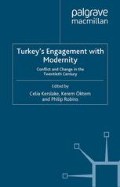Abstract
‘The speed with which a nation can transform itself is related to how well it can adapt to new styles in music’, declared an impatient Mustafa Kemal [Atatürk] during one of his keynote parliamentary speeches in Ankara in November 1934 (Saygun, 1981, p. 49). What he meant by ‘new styles in music’ was of course a suitable adaptation of the key principles of the Western classical tradition — its harmony, melody and form — to the indigenous music of Turkey, thus creating a balanced fusion fit for the new emerging Turkish state. Only after this transformation could the national music of Turkey, in his opinion, possibly be elevated to a universal musical level. ‘New Turkish Music’, in other words, was going to play an important role in the transformation of the country. All the young and promising composers of the republic were expected to fulfil their duties by writing music to serve the needs of the new regime, rooted of course in Turkey’s national heritage.1
Access this chapter
Tax calculation will be finalised at checkout
Purchases are for personal use only
Preview
Unable to display preview. Download preview PDF.
Bibliography
E. Araci (2004) ‘Dolmabahçe’den Bayreuth’a uzanan yardim eli’, Andante, no. 8, pp. 29–31.
E. Araci (2001) Ahmed Adnan Saygun, Dogu Bati Arasi Müzik Köprüsü ( Istanbul: Yapi Kredi Yayinlari).
E. Araci (2000) European Music at the Ottoman Court, CD 177 (Istabul: Kalan).
E. Araci (1999) The Life and Works of Ahmed Adnan Saygun, [Unpublished Ph.D. Thesis] (Edinburgh: Universuty of Edinburgh).
A. N. Arman (1979) ‘Muzika-i Humayun’un Avrupa Seferi’, Yillarboyu Tarih, no. 3.
S. Batu (1946) ‘Bir Sanat Basarisi’ (Ankara: Unknown publishing house).
N. Berkes (ed.) (1981) Turkish Nationalism and Western Civilization: Selected Essays of Ziya Gokalp (Westport: Greenwood Publishing Group).
G. Donizetti (ed.) (1897) Ricordi di Gaetano Donizetti, Esposti Nella Mostra Centenaria Tenutasi in Bergamo (Bergamo).
H. W. Dulcken (1983) The Complete Illustrated Stories of Hans Christian Andersen, ‘Mahomet’s Birthday — A Scene in Constantinople (London: Chancellor Press).
L. Eösze (1962) Zoltan Kodaly His Life and Work [Trans. Istvân Farkas and Gyula Gulyâs] (London: Collet’s).
J. Griffiths (1805) Travels in Europe, Asia Minor and Arabia (London: Printed for T. Cadell and W. Davies).
E. Ilyasoglu (1998) Contemporary Turkish Composers (Istanbul: Pan Yayincilik).
E. Ilyasoglu (1997) Cemal Resid Rey (Istanbul: Yapi Kredi Yayinlari).
Le Ménestrel (1836) 18 December
The Musical World (1839) 6 June
G. Oransay (1965) Batg Teknigiyle yazan 60 Türk Bagdar (Ankara: Küg Yayinlari).
P. Reed (2004) ‘Synthesis of East and West’, The Sunday Telegraph Review, 13 June.
A. Saygun (1981) Atatürk ve Musiki (Ankara: Sevda Cenap And Vakfi Müzik Yayinlan).
A. A. [Saygun] (1940) Halkevlerinde Musiki (Ankara: Cumhuriyet Halk Partisi Yayini).
D. Shostakovich (1981) Testimony (London: Robert Hale).
G. Skelton (1975) Paul Hindemith (London: Gollancz).
M. Stokes (1992) The Arabesk Debate (Oxford: Oxford University Press).
The Times (1843) 17 February.ai]
F. Zimmerman (1959) ‘New York: Turkish Music at the U. N.’, The Musical Times, February. Media and Popular Culture
Editor information
Editors and Affiliations
Copyright information
© 2010 Emre Araci
About this chapter
Cite this chapter
Araci, E. (2010). The Turkish Music Reform: From Late Ottoman Times to the Early Republic. In: Kerslake, C., Öktem, K., Robins, P. (eds) Turkey’s Engagement with Modernity. St Antony’s Series. Palgrave Macmillan, London. https://doi.org/10.1057/9780230277397_18
Download citation
DOI: https://doi.org/10.1057/9780230277397_18
Publisher Name: Palgrave Macmillan, London
Print ISBN: 978-1-349-31326-6
Online ISBN: 978-0-230-27739-7
eBook Packages: Palgrave Political & Intern. Studies CollectionPolitical Science and International Studies (R0)

